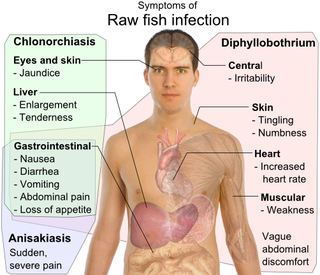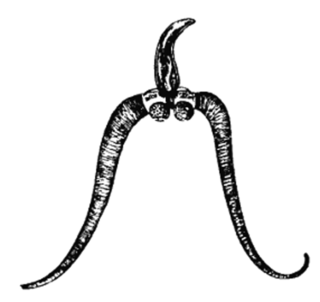
The flatworms, flat worms, Platyhelminthes, or platyhelminths are a phylum of relatively simple bilaterian, unsegmented, soft-bodied invertebrates. Being acoelomates, and having no specialised circulatory and respiratory organs, they are restricted to having flattened shapes that allow oxygen and nutrients to pass through their bodies by diffusion. The digestive cavity has only one opening for both ingestion and egestion ; as a result, the food can not be processed continuously.

Trematoda is a class of flatworms known as flukes or trematodes. They are obligate internal parasites with a complex life cycle requiring at least two hosts. The intermediate host, in which asexual reproduction occurs, is usually a snail. The definitive host, where the flukes sexually reproduce, is a vertebrate. Infection by trematodes can cause disease in all five traditional vertebrate classes: mammals, birds, amphibians, reptiles, and fish.

Digenea is a class of trematodes in the Platyhelminthes phylum, consisting of parasitic flatworms with a syncytial tegument and, usually, two suckers, one ventral and one oral. Adults commonly live within the digestive tract, but occur throughout the organ systems of all classes of vertebrates. Once thought to be related to the Monogenea, it is now recognised that they are closest to the Aspidogastrea and that the Monogenea are more closely allied with the Cestoda. Around 6,000 species have been described to date.

Clonorchiasis is an infectious disease caused by the Chinese liver fluke and two related species. Clonorchiasis is a known risk factor for the development of cholangiocarcinoma, a neoplasm of the biliary system.

Trematodes are parasitic flatworms of the class Trematoda, specifically parasitic flukes with two suckers: one ventral and the other oral. Trematodes are covered by a tegument, that protects the organism from the environment by providing secretory and absorptive functions.

Echinostoma is a genus of trematodes (flukes), which can infect both humans and other animals. These intestinal flukes have a three-host life cycle with snails or other aquatic organisms as intermediate hosts, and a variety of animals, including humans, as their definitive hosts.

Plagiorchiida is a large order of trematodes, synonymous to Echinostomida. They belong to the Digenea, a large subclass of flukes. This order contains relatively few significant parasites of humans.

Bucephalus polymorphus is a type of flatworm. This species is within the Bucephalidae family of Digenea, which in turn is a subclass of Trematodes within the phylum Platyhelminthes. It is characterized by having a mouth near the middle of its body, along with a sac-like gut. The mouth opening is located in the centre of the ventral surface. This is a specific body type of cecaria known as a gastrostome.

Clinostomum marginatum is a species of parasitic fluke. It is commonly called the "Yellow grub". It is found in many freshwater fish in North America, and no fish so far is immune to this parasite. It is also found in frogs. Clinostomum marginatum can also be found in the mouth of aquatic birds such as herons and egrets. They are commonly present in the esophagus of fish-eating birds and reptiles. Eggs of these trematodes are shed in the feces of aquatic birds and released into water. Aquatic birds become hosts of this parasite by ingesting infected freshwater fish. The metacercariae are found right beneath the skin or in the muscles of host fish.
Bucephalus mytili is a parasitic flatworm of the class Trematoda. It is a parasite of fish and a parasitic castrator of the mussel Mytilus edulis, where it destroys the mussel's gonads and causes the mussel to grow much larger than normal.

Bucephalus is the genus name for many trematode flatworms that are parasites of molluscs and fish. Like other Bucephalidae, they are found in fish both as adults and as metacercariae. In marine and freshwater teleosts, they live as parasites inside the digestive tract, especially the intestine.

Bucephalidae is a family of trematodes that parasitize fish. They lack suckers, having instead a muscular organ called a "rhynchus" at the front end which they use to attach to their hosts. The characteristics of the rhynchus are used to help define the genera of the family. It is one of the largest digenean families, with 25 genera containing hundreds of described species. Bucephalids are cosmopolitan, having been recorded all over the world. They are parasites of fish from freshwater, marine, and brackish water habitat types.
Microphallus turgidus is a widespread and locally common flatworm parasite in New Zealand lakes and streams. Multilocus allozyme genotype data show that Microphallus turgidus is a single outbred species with high levels of gene flow among South Island populations. Microphallus turgidus is commonly found in the abdominal muscles of grass shrimp.

Gastrodiscoides is genus of zoonotic trematode under the class Trematoda. It has only one species, Gastrodiscoides hominis. It is a parasite of a variety of vertebrates, including humans. The first definitive specimen was described from a human subject in 1876. It is prevalent in Bangladesh, India, Burma, China, Kazakhstan, Philippines, Thailand, Vietnam, and the Volga Delta of Russia, with isolated cases from Africa, such as Nigeria. It is especially notable in the Assam, Bengal, Bihar, Madhya Pradesh, Orissa and Uttar Pradesh regions of India.

Opecoelidae is a family of trematodes. It is the largest digenean family with over 90 genera and nearly 900 species, almost solely found in marine and freshwater teleost fishes. It was considered by Bray et al. to belong in the superfamily Opecoeloidea Ozaki, 1925 or the Brachycladioidea Odhner, 1905.
Brachylaimidae is a family of parasitic flukes in the sub-class Digenea. Adults are usually found within the digestive tracts and other organs of mammals or birds and have a complex three-stage life cycle.
Allopodocotyle is a genus of trematodes in the family Opecoelidae.
Anomalotrema is a genus of trematodes in the family Opecoelidae.

Allocreadiidae is a family of flatworms belonging to the order Plagiorchiida. In their adult stage they parasitize teleosts through their digestive system; they can also parasitize other vertebrates in freshwater ecosystems such as frogs, salamanders, and snakes. Allocreadiidae are distinguished from other Trematoda in the cercarial stage, where the cercaria have both an eye-spot and a stylet. The cercaria of Allocreadiidae also develop in lamellibranchs, whereas many other trematodes develop in gastropods.












